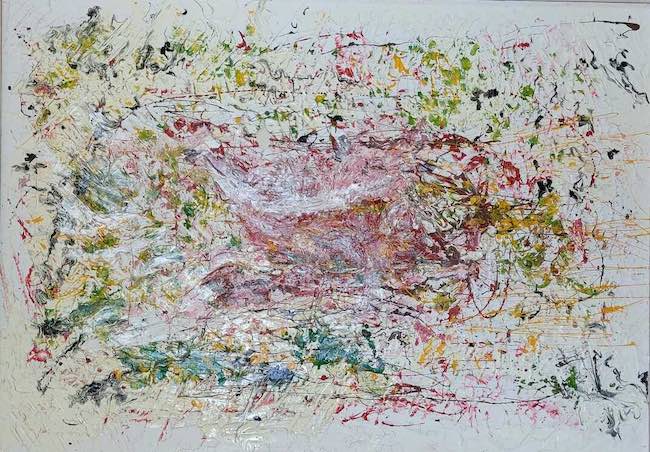L’esigenza di lasciarsi andare a tutto quel turbinìo di sensazioni che colpiscono in maniera quasi inconsapevole l’emotività, è una forte spinta espressiva per tutto quel gruppo di artisti che hanno bisogno di distaccarsi completamente dall’osservato e di rinunciare a qualsiasi riferimento visivo a cui la mente potrebbe aggrapparsi per reclamare il suo spazio; uno stile pittorico completamente informale permette invece all’istinto di trovare la sua vera voce, quella che nella quotidianità non riesce a farsi sentire perché posta in silenzio dal dialogo costante con la logica e dalla mediazione della ragione. Le emozioni in questo caso riescono a raggiungere in maniera immediata e spontanea la tela che si presta pertanto a essere elemento interpretativo di un’immediatezza che necessita di trovare il suo spazio. L’artista di cui vi racconterò oggi non solo lascia fluire liberamente le sue sensazioni più profonde senza il condizionamento della forma, ma declina anche la mancanza di riferimenti visivi a una delicatezza interiore che si rivela nelle tonalità delle sue opere.
Intorno agli anni Cinquanta del Novecento, il mondo dell’arte fu costretto a fare il punto della situazione, a ereditare le innovazioni delle avanguardie dei primi decenni trovando un modo per superare i limiti e le regole che avevano contraddistinto i movimenti più rivoluzionari di tutta la storia dell’arte precedente; la corrente che più di tutte aveva spezzato ogni legame con gli schemi accademici tradizionali fu quella Informale, intesa come rinuncia alla forma conosciuta per sottolineare quanto il gesto plastico della creazione fosse puro al di là del soggetto rappresentato, e contenesse in sé la superiorità assoluta verso qualsiasi altra forma di riproduzione delle immagini. Tuttavia, a parte la breve parentesi iniziale dell’Astrattismo Lirico di Vassily Kandinsky, ciò su cui si concentrarono tutte le correnti astrattiste fu l’esclusione della soggettività, del sentire dell’autore dell’opera perché essa avrebbe tolto al gesto plastico la purezza esecutiva; ma il distacco dal mondo interiore generò una certa freddezza nelle opere dei protagonisti del De Stijl, del Suprematismo e delle sperimentazioni della Bauhaus. Così negli Stati Uniti nacque un gruppo artistico fondato da Jackson Pollock, Willem de Kooning, Mark Rothko e Franz Kline, che prese il nome di Espressionismo Astratto, dove la mancanza di forma conosciuta e di riferimenti visivi si amalgamava con il recupero di quel mondo interiore, della soggettività dell’esecutore dell’opera che aveva contraddistinto la rivoluzione dei Fauves e dell’Espressionismo. Il punto focale di questo nuovo movimento che ben presto si diffuse e trovò grandi esponenti anche nel Vecchio Continente, era appunto che ogni tela dovesse essere avvolta dalle sensazioni dell’autore, sebbene i fondatori, già caratterizzati da stili difformi, sottolinearono l’importanza dell’assoluta libertà nella scelta del linguaggio e della tecnica più in armonia con le proprie personalità creative. I più impulsivi e travolgenti si avvicinarono dunque al Dripping, che caratterizzò Jackson Pollock e la moglie Lee Krasner, i più meditativi, come Mark Rothko ed Helen Frankenthaler, scelsero il Color Field più suggestivo e introspettivo, gli ermetici, come Franz Kline e Adolf Gottlieb si avvicinarono alla pittura segnica liberatoria quanto in realtà espressione primordiale del loro sentire. Da quel momento in avanti l’Astrattismo evolse e il distacco tra mondo della non forma ed emotività fu colmato da opere in grado di travolgere l’osservatore con la loro spontaneità e trasformando per la prima volta il gesto della creazione, l’Action painting, in parte stessa dell’opera.
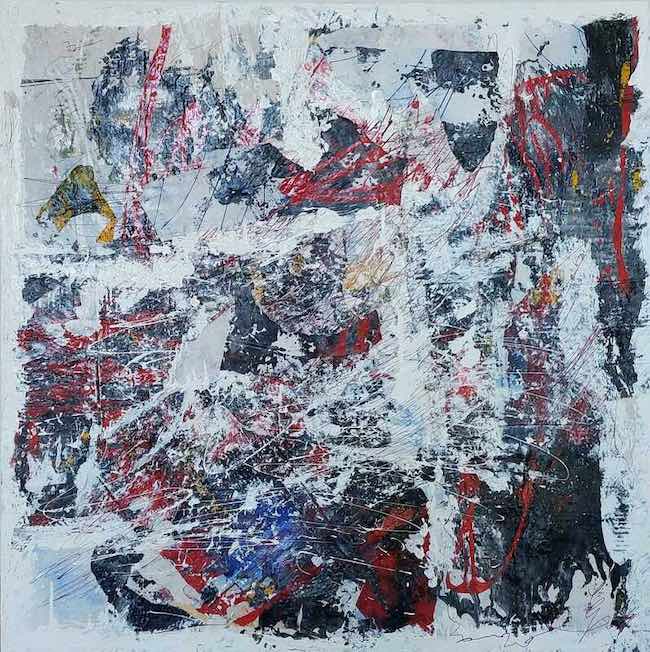
L’artista calabrese Carmela Bueti sceglie proprio il Dripping di Pollock per raccontare il suo ricco mondo interiore fatto di sensazioni ma anche di osservazione dei luoghi visitati durante i viaggi che frequentemente ama compiere, come se la sua ispirazione avesse bisogno di attingere alla conoscenza, all’esplorazione, per poi riuscire a concretizzarsi sulla tela; ed è forse proprio questa spinta alla scoperta, che si traduce dal punto di vista espressivo in una ricerca completamente nuova, inedita, a condurla a dare un aspetto diverso e nuovo, più concreto, a quell’impulsività esecutiva che aveva contraddistinto il Dripping originale. Le sue opere infatti sono costituite da materia, prevalentemente smalti ma anche vetrificazioni, stucco, legno, pur avendo come risultato visivo finale lo stesso ottenuto da Pollock nelle sue opere, con la variante però che in Carmela Bueti l’impulsività del gesto plastico del lanciare il colore, o i materiali, sulla tela viene attenuata da una posizione più meditativa, più interiorizzata e affine alla sua delicatezza percettiva.
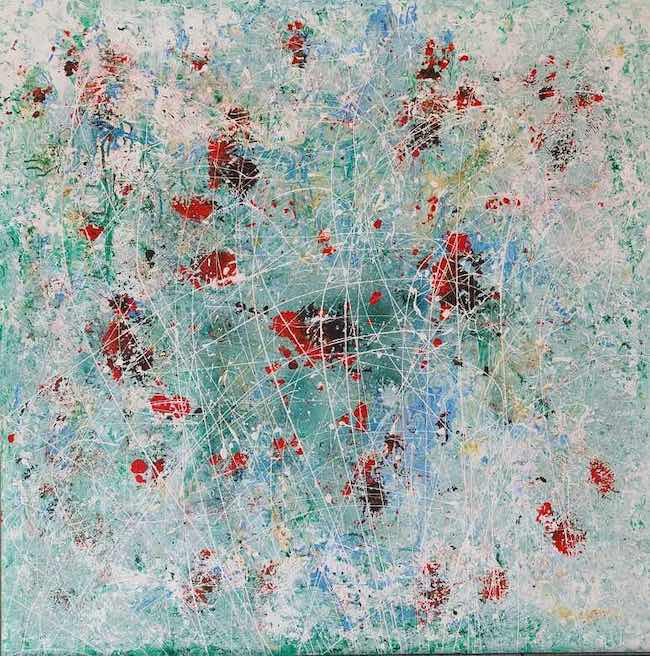
Pertanto la gamma cromatica è più tenue, gli sfondi sono prevalentemente quasi sempre chiari, come se il suo approccio conoscitivo fosse quello che tende verso la luce, verso il chiarore, ed è poi da lì che sembrano comporsi i pensieri, i frammenti di emozioni dell’artista o gli spunti di meditazione che hanno generato l’opera. In alcuni dipinti emerge anche la tecnica del grattage attraverso la quale la Bueti enfatizza alcuni concetti infondendo nell’osservatore un senso di incisività, la consapevolezza di una stratificazione delle sensazioni e delle emozioni che può essere scalfita solo apparentemente perché invece la vera sostanza rimane.
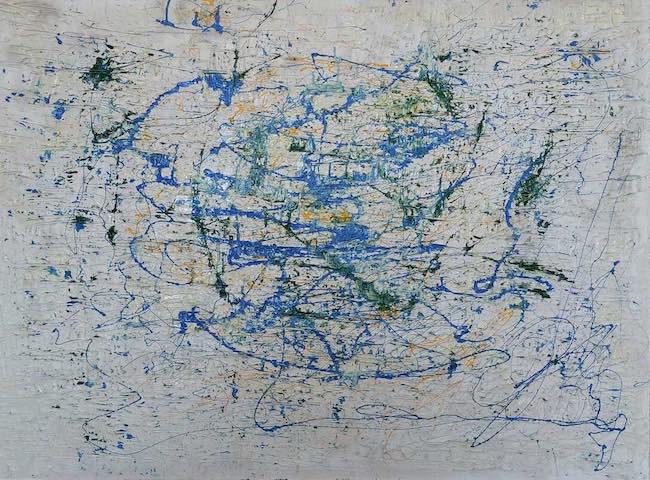
La base bianca dunque diviene punto di partenza della poliedricità di tutto ciò che rappresenta un pensiero, un’idea, un ricordo, l’interpretazione di un concetto filosofico, ogni dettaglio colto dall’artista nel corso della sua esistenza viene filtrato dal suo scrigno emotivo, affidato al materiale più affine a quel particolare frangente e poi lanciato sulla tela come se in un secondo momento divenisse urgente raccontarle le emozioni affiorate.
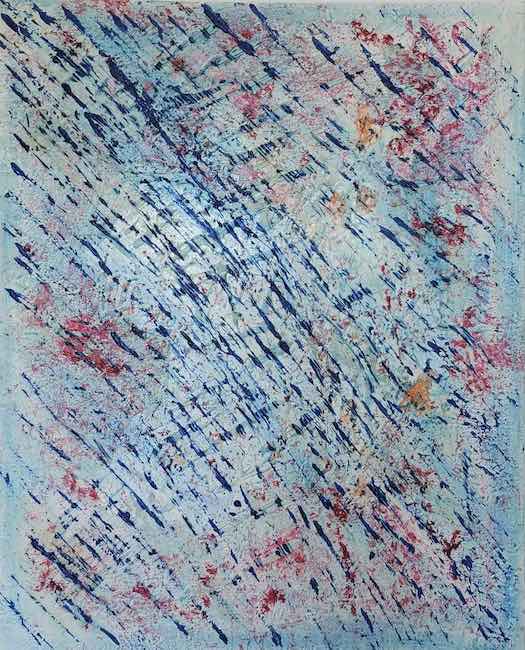
L’opera Lettera ad un amico, realizzata con smalti vetrificati su tela, mostra l’enfasi di un’emozione da comunicare e al tempo stesso la consapevolezza di dover ordinare i pensieri per renderli leggibili, quasi come se Carmela Bueti volesse puntare l’attenzione su quanto il dialogo sia complesso e costantemente a rischio di fraintendimento; le striature azzurre ricordano le righe di scrittura sebbene di fatto siano semplici linee astratte, e la delicatezza dello sfondo sta a sottolineare quanto siano preziosi quei pensieri tradotti in espressione visiva, quanto importanti siano tutte le piccole sensazioni che all’interno della composizione sembrano liberarsi.
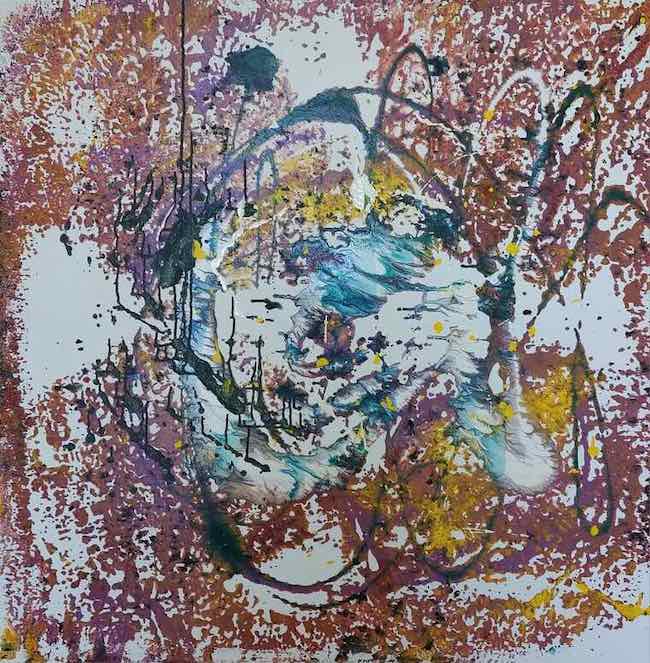
In Fuori dal nido invece la base bianca viene quasi coperta dalle ramificazioni degli smalti che costituiscono il contorno di un nucleo centrale, metafora di quel rifugio dentro cui spesso l’essere umano preferisce chiudersi per non uscire dalla sua rassicurante zona sicura; tuttavia l’uomo, suggerisce Carmela Bueti, ha bisogno di evolvere, liberarsi di ciò che sembra comodo per comprendere qualcosa di sé che diversamente non conoscerebbe mai. Ecco dunque che il centro si arricchisce di tonalità più variegate, perché in fondo è solo aprendosi alla vita che si possono scoprire tutte le più reali sfumature. Anche in questa tela lo smalto sostituisce l’acrilico rendendo il Dripping più lucido, cangiante, tanto quanto lo è la realtà e la soggettività dei punti di vista, delle culture, degli usi e costumi che Carmela Bueti conosce bene proprio in virtù dei molti paesi visitati e da cui ha appreso il fascino della diversità e la bellezza della sua accettazione.
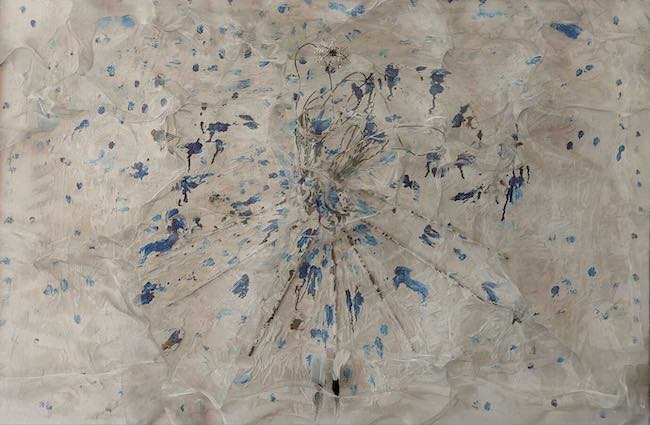
Nella tela Tracce di fiordaliso l’artista diviene persino più audace perché introduce la terza dimensione, prima di tutto utilizzando lo stucco come sottostrato concreto dove poi lancia il colore azzurro tipico del fiore evocato nel titolo, e poi ancora va a ondulare il risultato finale attraverso una sottile rete metallica che da un lato cerca il contatto con l’esterno ma dall’altro può assumere anche la doppia valenza di protezione della delicatezza del fiore. Il tema dell’andare e del restare, del seguire il proprio istinto o del rinunciare a farlo, è costantemente presente nelle opere di Carmela Bueti, come se di fatto per lei l’esistenza fosse sempre un bivio, come se ogni istante della vita l’essere umano fosse sottoposto a scelte che possono cambiare il corso degli eventi e dunque non esiste destino già prestabilito, esiste la costante autodeterminazione che tuttavia niente ha a che vedere con l’irruenza. Si può seguire la propria natura anche semplicemente ascoltandosi e prendere le proprie decisioni con serenità, è questo che emerge dalle sue opere, quell’equilibrio pacato e consapevole che diviene così esortazione nei confronti dell’osservatore a scavare dentro se stesso, accogliere le proprie debolezze e fragilità e trasformarle in punti di forza, anche a dispetto dei graffi a cui spesso l’anima viene sottoposta.
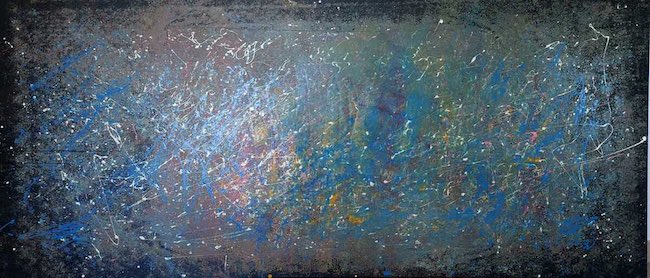
Carmela Bueti ha al suo attivo la partecipazione a mostre collettive e personali, dove riceve apprezzamenti dal pubblico, che viene colpito dalla delicata impulsività delle opere, e dagli addetti ai lavori affascinati dal suo uso della materia trasformata nell’aspetto in puro colore.
CARMELA BUETI-CONTATTI
Email: linaboscarino@libero.it
Facebook: www.facebook.com/carmela.bueti
Instagram: www.instagram.com/bueticarmela/
Linkedin: www.linkedin.com/in/carmela-bueti-22b89655/
When impulsiveness is tamed by reflection in Carmela Bueti’s vibrant and material Dripping
The need to let go of all that whirlwind of sensations that almost unconsciously strike the emotionality, is a strong expressive drive for all those artists who need to detach themselves completely from the observed and renounce any visual reference to which the mind could cling to claim its space; a completely informal pictorial style instead allows instinct to find its true voice, the one that in everyday life cannot be heard because it is silenced by the constant dialogue with logic and the mediation of reason. Emotions in this case manage to reach the canvas in an immediate and spontaneous manner, which therefore lends itself to being an interpretative element of an immediacy that needs to find its space. The artist I am going to tell you about today not only lets her deepest feelings flow freely without the conditioning of form, but also declines the lack of visual references to an inner delicacy that is revealed in the tones of her artworks.
Around the 1950s, the art world was forced to take stock of the situation, to inherit the innovations of the avant-gardes of the first decades and find a way to overcome the limitations and rules that had marked the most revolutionary movements in the entire history of art before; the current that most of all had broken all ties with traditional academic schemes was the Informal one, understood as the renunciation of known form to emphasise how the plastic gesture of creation was pure beyond the subject represented, and contained within itself absolute superiority to any other form of image reproduction. However, apart from the brief initial parenthesis of Vassily Kandinsky‘s Lyrical Abstractionism, what all the abstractionist currents focused on was the exclusion of subjectivity, of the feeling of the author of the artwork because it would have deprived the plastic gesture of its executive purity; but the detachment from the inner world generated a certain coldness in the works of the protagonists of De Stijl, Suprematism and the Bauhaus experimentation. Thus, in the United States, was born an artistic group founded by Jackson Pollock, Willem de Kooning, Mark Rothko and Franz Kline, which took the name of Abstract Expressionism, where the lack of known form and visual references was amalgamated with the recovery of that inner world, of the subjectivity of the artwork’s executor that had marked the revolution of the Fauves and Expressionism. The focal point of this new movement, which soon spread and found great exponents even in the Old Continent, was precisely that each canvas should be enveloped in the author’s feelings, even though the founders, already characterised by different styles, emphasised the importance of absolute freedom in the choice of language and technique most in harmony with their own creative personalities. The most impulsive and overwhelming approached Dripping, which characterised Jackson Pollock and his wife Lee Krasner, the most meditative, such as Mark Rothko and Helen Frankenthaler, chose the more evocative and introspective Colour Field, the hermetic, such as Franz Kline and Adolf Gottlieb approached sign painting as liberating as it was in reality the primordial expression of their feelings. From that moment on, Abstractionism evolved and the gap between the world of non-form and emotionality was bridged by works capable of overwhelming the observer with their spontaneity and transforming for the first time the gesture of creation, Action painting, into part of the work itself.
Calabrian artist Carmela Bueti chooses precisely Pollock‘s Dripping to narrate her rich inner world made up of sensations but also of the observation of places visited during the journeys she frequently takes, as if her inspiration needed to draw on knowledge, on exploration, in order to be able to materialise on canvas; and it is perhaps this drive for discovery, which translates from an expressive point of view into a completely new, unprecedented research, that has led her to give a different, new, more concrete aspect to that executive impulsiveness that had characterised the original Dripping. Her artworks in fact consist of materials, mainly enamels but also vitrified, stucco, wood, although their final visual result is the same as that obtained by Pollock in his paintings, with the variant, however, that in Carmela Bueti the impulsiveness of the plastic gesture of throwing the colour, or materials, onto the canvas is attenuated by a more meditative position, more interiorised and akin to her perceptive delicacy. Therefore, the colour palette is more subdued, the backgrounds are predominantly light, as if her cognitive approach is one that tends towards the light, towards chiaroscuro, and it is then from there that the artist’s thoughts, fragments of emotions or meditative cues that generated the work seem to compose themselves. In some paintings also emerge the technique of grattage through which Bueti emphasises certain concepts, instilling in the observer a sense of incisiveness, the awareness of a stratification of sensations and emotions that can only be scratched apparently because the true substance remains. The white base therefore becomes the starting point of the multifacetedness of everything that represents a thought, an idea, a memory, the interpretation of a philosophical concept, every detail the artist has grasped in the course of her existence is filtered from her emotional treasure chest, entrusted to the material most akin to that particular juncture and then thrown onto the canvas as if it became urgent to recount the emotions that have surfaced.
The painting Lettera ad un amico (Letter to a Friend), created with vitreous enamel on canvas, shows the emphasis of an emotion to be communicated and at the same time the awareness of having to order thoughts to make them readable, almost as if Carmela Bueti wanted to draw attention to how complex dialogue is and constantly at risk of misunderstanding; the blue streaks recall the lines of writing even though they are in fact simple abstract lines, and the delicacy of the background emphasises how precious those thoughts translated into visual expression are, how important are all the small sensations that seem to be released. In Fuori dal nido (Out of the nest), on the other hand, the white base is almost covered by the ramifications of the enamels that make up the outline of a central core, a metaphor for that refuge within which human beings often prefer to shut themselves so as not to leave their reassuring safe zone; however, man, Carmela Bueti suggests, needs to evolve, to free himself from what seems comfortable in order to understand something of himself that he would otherwise never know. Hence, the centre is enriched with more variegated shades, because after all, it is only by opening to life that one can discover all the most real nuances.
In this canvas too, enamel replaces acrylic, making Dripping more shiny, iridescent, as much as it is the reality and subjectivity of points of view, cultures, customs and traditions that Carmela Bueti knows well precisely by virtue of the many countries she has visited and from which she has learnt the fascination of diversity and the beauty of its acceptance. In the canvas Tracce di fiordaliso (Cornflower traces), the artist becomes even more daring because she introduces the third dimension, first of all by using stucco as a concrete substrate where she then casts the light blue colour typical of the flower evoked in the title, and then again by undulating the final result through a thin metal mesh that on the one hand seeks contact with the outside but on the other it can also take on the double value of protecting the delicacy of the flower. The theme of going and staying, of following one’s instinct or renouncing it, is constantly present in Carmela Bueti‘s paintings, as if for her existence were always a crossroads, as if every moment of life the human being were subjected to choices that could change the course of events and therefore there is no pre-established destiny, there is constant self-determination that nevertheless has nothing to do with impetuosity. One can also follow one’s own nature by simply listening to oneself and making one’s own decisions with serenity; this is what emerges from her artworks, that calm and conscious balance that becomes an exhortation to the observer to dig deep within himself, to accept his own weaknesses and frailties and transform them into strengths, even in spite of the scratches to which the soul is often subjected. Carmela Bueti has to her credit the participation in group and solo exhibitions where she has received appreciations from the public, struck by the delicate impulsiveness of her artworks, and from insiders who are fascinated by her use of matter transformed in appearance into pure colour.


